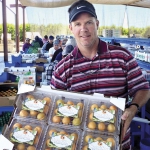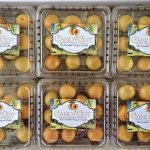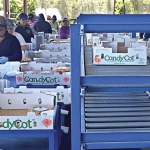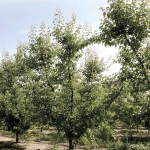The incredibly sweet CandyCot apricots are a hit with consumers, but there’s been a steep learning curve on the production side, says CandyCot partner Chris Britton.
CandyCots are a series of apricot varieties and selections with origins from Central Asia. The CandyCot name is trademarked and represents a partnership between two California family farms: Driver Family Farms in Waterford and Britton Konynenburg Partners in Salida, a partnership of Chris Britton and Paul Van Konynenburg. CandyCots are a managed or club variety on a small scale.
To be a CandyCot apricot, the selection must meet certain standards, Britton said. Fruit must be high in sugar—at least 22° Brix (most average 26° Brix)—and possess unique eating qualities.
“Eating quality is not based on size,” he said. “What we’re looking for is complexity of flavors. We’re not looking for a sugar bomb—one of our selections was 32° Brix, but it was like eating a sugar cube. We’re after complexity of flavors, a term winemakers often use.”
CandyCot apricot selections come in several flesh colors—some are intensely orange, some are white, some yellow. Fruit are small or medium in size. “Most of the varieties are genetically quite small, so we are looking at crossing selections to achieve larger fruit,” Britton said. “But we’re really opposed to losing the eating qualities just to have larger fruit.”
|
Currently, two varieties are in commercial production, and four more are in commercial testing. In addition to the Driver and Britton Konynenburg orchards and the one outside grower, testing agreements are in place at Oasis Farms in Prosser, Washington; Red Jacket Orchards in Geneva, New York; and Andy’s Orchards in Morgan Hill, California. There are also testing agreements in Spain, France, and Italy. About 125 acres total have been planted thus far.
The CandyCot package is as unique as the fruit.
Fruit are packed in only one type of package—a one-pound, foam-lined clamshell that looks like a candy box. Inside the box, fruit are nestled in a Panta-Pak to prevent movement in the clamshell. Four fruit sizes are available: 9-, 11-, 12-, and 14-count. Suggested retail price is $5.99 per pound.
Harvest usually starts around June 12 and lasts for about a month. This is the third year of commercial production.
Picking, handling, and packing the fragile fruit is very labor intensive. Extra care must be used because fruit are picked at very high maturity. The tender apricots are touched by humans twice, once when picked and placed into a foam-cushioned, Panta-Pak-lined, small lug and then again on the small, outdoor packing line when sorters put fruit in the appropriate clamshell.
The high sugar content often causes fruit to have small brown spots or scuffing on the surface. These are sugar spots, Britton explained, and added that they include information in the packages to educate consumers about the spots.
Not enough
Demand has been unbelievable and has way outpaced supply, Britton said to Good Fruit Grower during a visit in late spring, just ahead of CandyCot season. Foodies are the kind of people who love CandyCots.
“We’ve had no problem selling fruit,” he said. “We’re selling it ourselves and have to say no to the vast majority of customers.” Currently, they are working primarily with four customers, including HEB-Texas Central Markets, Raley’s, a California market, and the online produce marketer Fresh Direct in New York.
Saying no is not a terrible thing, he said, but it’s been difficult to project volumes because they don’t have years of experience behind them. CandyCot trees range in age from sixth to third leaf. In 2013, they packed about 10,000 cartons. This year, they had hoped for 18,000 cartons, but hail damage from a late spring storm reduced the crop to around 10,000 cartons.
“The thing that we’re struggling with is not sales, not packing, and not demand, but how to get more fruit to set on the trees,” Britton said. “These fruit come from a region with very, very high chill, and once spring hits, bloom is instant and temperatures go from cold to hot. There are probably some adaptability issues for this region, but we’re getting there.”
No manual
There’s no manual to help them. “It just means it takes longer for us to get there,” he said. Fruit set was light in 2014, in part a result of few chill hours logged in California’s San Joaquin Valley. He is also growing apricots on a V-trellis, which is very different than the large trees of Central Asia and could be part of its adaptability issues.
Most of the crops (apples, cherries, and cling peaches) grown by Britton Konynenburg are on the V-trellis, though apricots are a new experience for the company. The V-trellis provides good light penetration and labor efficiencies. Apricot trees are planted 12 feet apart by 15 feet between rows, totaling 242 trees per acre. They thin to achieve about 400 fruit per tree. Pruning has been done in late summer (the varieties are very susceptible to bacterial canker so winter pruning is avoided), but they’re going to try pruning in late spring to see if fruit set can be improved.
Britton is also going to try overhead evaporative cooling in winter months to make temperatures colder. Evaporative cooling is used in the company’s apple orchards. He’ll also try spraying the trees with kaolin clay in winter months to reflect light, similar to painting trunks white to prevent sunburn.
Both methods are easy and relatively cheap.
His production target is around five tons per acre. “We haven’t hit it yet, but we were close last year until severe wind knocked fruit off right before harvest.” Typical apricot yields in his area are seven to eight tons per acre.
Another research and development project is to find an outlet for off-grade fruit. Packouts are around 20 to 30 percent, and because they only pack one grade, they need more outlets.
Farmers’ markets take off-grade fruit, but a market for culls is needed. Possibilities include using IQF (individual quick freeze) to freeze-dry fruit for the snack market, freezing fruit in blocks for foodservice and specialty processors, and doing their own drying.
“We’ve had interest from other growers, but we’re not willing to allow growers to take such a risk until we can get productivity figured out,” he said. “I even question why we let one outside grower plant 25 acres a couple years ago.”
He’s cautiously optimistic they will come up with solutions. For the time, money, and effort he’s put in this project, he says he could have planted 100 acres of almonds. “It would have been so much simpler. But I’ll see this to its conclusion. It’ll either be a great success or utter failure.”
From the start, he’s been sold on the eating quality of the apricots. In the beginning, they held numerous taste tests at farmers’ markets. CandyCots were always the most preferred, Britton said. “We know there’s a market for fruit with great eating quality and believe there’s a great future. But we have to do it consistently and be consistent with our yields.”









Leave A Comment